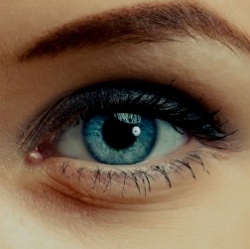
While Virtual Reality is all the rage right now, the current generation of headsets, such as the Oculus Rift and HTC Vive can’t match the visual fidelity of the human eye. A Finnish startup called Varjo launched today to fix that with new technology that takes advantage of how we see to provide better headset graphics than what’s on the market today.
Varjo is building a headset for creative professionals that will provide a premium VR experience, according to Urho Konttori, the firm’s founder and CEO. The headset is called the 20|20, after the term for perfect vision for the human eye. (It’s also possible to see the 20/20 line in a digital eye chart inside the headset.)
While current virtual reality headsets are good enough for gaming, Konttori said, they don’t provide enough fidelity to do things like high-precision graphics work. Varjo aims to fix that with its headset by using a high-resolution OLED display in addition to a lower-resolution panel. The company then moves the display around the field of view in line with where a user is looking in order to trick that person’s eyes into thinking that they’re seeing a far higher-resolution image.
That all works because of how the human eye is set up. While it may seem like we see in high definition throughout our entire field of view, humans only see in the highest clarity inside a five degree area of their vision, known as the fovea. Because the eye can only move so fast, all Varjo has to do is match those movements in order to provide high-resolution imagery.
It’s a risky approach, however: If Varjo’s headset doesn’t work in time with its wearer, the results could be jarring. The company brought an Oculus Rift headset to San Francisco that had been retrofit with its display technology to show high-resolution images in the center of the headset’s display. It showed a slight shimmer on the border between the low- and high-resolution portions that proved a tiny bit disorienting.
In time, Varjo’s technology has the potential to help bring virtual and augmented reality together. The company wants to take a video feed, show that to the headset’s wearer, and then enable a set of digital effects laid over the information about someone’s surroundings.
In a set of pre-taped demos, the company showed how that approach could be used to provide a set of mixed reality effects that can’t be done with transparent headsets like the Microsoft HoloLens. For example, it’s possible to reduce how bright a room is just by altering its digital representation.
Varjo still has a journey ahead before its technology is ready for prime time. The company plans to start shipping its first developer kits at the end of this year, but the team hasn’t revealed how it plans to move the high-resolution display image around a user’s field of view in its production hardware.
However, this is a team with experience building hardware, as the company includes veterans of Nokia and Microsoft.
Once the headset starts shipping, users shouldn’t expect to pick it up for the same price as an Oculus Rift or HTC Vive. The company is explicitly targeting premium customers in creative fields, which means that the resulting headset will come with a hefty price tag.
The company’s other key issue is getting developers to update their software to work with Varjo’s headsets. With that in mind, the headset will be compatible with SteamVR, so apps built for that ecosystem will be compatible with it, and the hardware will also work with experiences built in Unity and Unreal, the two most popular engines for VR content.
